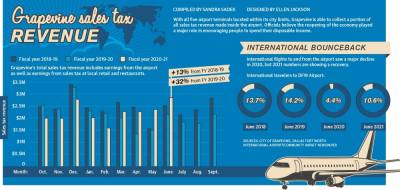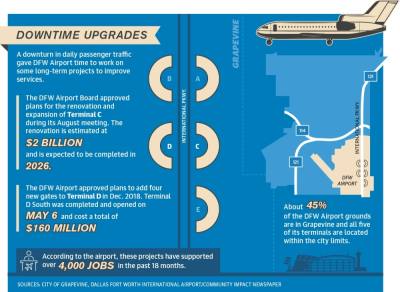DFW Airport saw a 35% decrease in total passengers coming through the airport between fiscal year 2018-19 and fiscal year 2019-20, according to data from the airport due to travel restrictions resulting from the coronavirus pandemic.
Now, an easing of health restrictions in Texas and the introduction of COVID-19 vaccinations earlier this year have set the stage for a shift in the demand for air travel as more passengers book tickets again.
Even with the uncertainty created by the surge in delta variant cases in the North Texas region, the increased demand for air travel has boosted the bottom line for the airport and the local economy of the host cities of Grapevine, Euless, Coppell and Irving.
“During COVID-19, there’s more recognition than ever that regional growth and regional success matters to everybody,” said Grapevine Mayor Pro Tem Darlene Freed. She is a past member of the DFW Airport Board—a body that includes 11 members appointed by the owner cities of Dallas and Fort Worth, and one rotating non-voting member from one of the host cities.
As one of four cities which the airport calls home, Grapevine’s tourism industry is intertwined with the airport’s to successfully bring traffic and revenue to the city.
Supporting the local economy
Like many tourist destinations, Grapevine’s economy saw a downturn during its typically busy months due to pandemic-related travel restrictions.
But, the recent increase in air travel—especially business and leisure travel seen in the last six months—at DFW Airport has had a positive impact on the city, according to Paul W. McCallum, executive director at the Grapevine Convention and Visitors Bureau.
“[Traveling] converts to a hotel stay. It converts to [spending] in restaurants and retail,” he said.
McCallum said the Convention and Visitors Bureau estimates leisure travel currently accounts for around 60% of all visitors coming through downtown, compared to only making up about 15%-20% of the travel coming through the city before the pandemic.
“It’s a big swing, [but] it isn’t going to stay that way,” McCallum said. “We can see the trend now because the future bookings that we’re making for 2022 and 2023—you can already see the strong return of the group business [travel].”
One of Grapevine’s advantages is all five of the airport’s terminals are located within its city limits, meaning the city of Grapevine collects a portion of sales taxes accrued from purchases in the terminals.
Data from the city of Grapevine shows sales tax revenue for June 2021—totaling $2.8 million—has already surpassed revenue from the same month in 2018 and 2019, raising $2.7 million and $2.5 million, respectively. In June 2020, the city raised $2.1 million.
While it is unclear how much the surge in air travel played into that increased sales tax revenue, Grapevine Chief Financial Officer Greg Jordan said the reopening of Texas in spring 2021 encouraged individuals to spend their disposable income.
“The growth we’re seeing is very consistent with what we saw roughly three years ago,” Jordan said. “If we project that forward based on the same trend line [as we work on fiscal year 2021-22], it really represents very closely the same values that we saw on fiscal year 2018-19.”
Growth supports jobs
The decreased volume of passengers during the pandemic gave the airport time to proceed with the expansion and remodeling of several terminals.
On Aug. 9, the airport board announced an estimated $2 billion in projects to renovate and expand Terminal C. This project is expected to be completed in 2026, according to a news release.
“The goal is to transform Terminal C, which has stood in service at the airport since the early ‘70s, into a modern terminal with the latest technologies and infrastructure,” DFW Airport CEO Sean Donohue said in a press release. “DFW is providing for the anticipated growth of our partner, American Airlines, while also elevating the customer experience to meet the needs of the modern traveler.”
The airport recently completed its expansion of Terminal D South, adding four additional gates at a total cost of $160 million. It also renovated the High C gates, opened a state-of-the-art Integrated Operations Center and upgraded runways and taxiways.
According to the airport, these projects have supported over 4,000 jobs in the past 18 months.
The jobs come in line with a resurgence of passenger traffic through DFW Airport. A presentation provided to the airport board on Aug. 5 shows DFW Airport is “recovering faster than most airports.” An estimated 67.2 million passengers are projected in the fiscal year beginning Oct. 1 2021—a 26.5% increase from the current fiscal year 2020-21.
While current passenger traffic is still 8.5% less than in pre-pandemic years, officials expect the airport to make a full recovery in fiscal year 2022-23.
Freed said the airport’s owner cities and the host cities all compete with one another for businesses.
“[DFW Airport] did a good job of working with all the cities in the whole community to make it a success for the whole region and not just one over the other,” she said.








